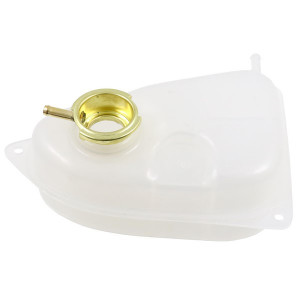Expansion tank
Ligier 162 , Ambra / Microcar MGO 1 (1st assembly) / Casalini Kerry , Sulky 2008 , M10 , M110 , M12 , M14…
New-origin
In stock
€52.92
or 4 x 13.23 €
The expansion tank is an indispensable element of the cooling circuit of your car-free car. It serves as a buffer tank for the cooling liquid and makes it possible to compensate for variations in volume caused by temperature changes. An expansion tank in good condition guarantees a perfectly sealed cooling circuit, prevents liquid losses and protects the engine against overheating. Find out on this page our selection of compatible expansion vessels for all license car brands, to ensure reliable and sustainable maintenance.
When the engine heated, the cooling liquid expands and increases in volume. The expansion vessel can absorb this excess and avoid any overpressure in the radiator or hoses.
The expansion tank makes it easy to control the coolant level by "min" and "max" marks. This helps quickly detect leakage or lower level.
A correctly filled circuit prevents the formation of air bubbles, which could cause cavitation and damage the water pump.
A cracking, cracked or connectors are worn can let the liquid escape. This leads to too low level and increases the risk of engine overheating.
A non-sealed vase or the plug no longer holds the pressure causes a decrease in the boiling point of the liquid, which promotes overheating.
Unwengt vacpreted overpressure can damage the radiator, explode the hoses or cause leaks at different points of the circuit.
The presence of deposits of dried or whitish liquid on or around the expansion vessel often indicates a leak or microfissure.
Over time, the plastic of the expansion tank can yellow, become brittle and crack. These signs indicate that it must be replaced before it does not fully yield.
If you feel a hot coolant smell or observe steam from the engine compartment, immediately check the state of the expansion tank.
A level that rises or drops quickly without apparent reason can be a sign of a problem in the expansion vessel or in the pressure cap.
Check the state of the vase at each drain or every 6 months. The walls should be translucent to allow easy control of the liquid level.
The expansion tank cap is a safety piece that keeps the pressure in the circuit. Replace-If it has signs of wear. You will find our compatible plugs here: Expansion tank caps for car without a license.
Use a cooling liquid compliant with recommendations to prevent accumulation of deposits and extend the life of the expansion tank and the rest of the circuit.
Before replacing the vase, it is advisable to drain the circuit to avoid liquid losses and the introduction of air.
Make-You will correctly reconnect the hoses and replace the necklaces if necessary. A bad clamping can lead to leaks and compromise the effectiveness of the circuit.
After installation, purge the cooling circuit to remove air bubbles and ensure a homogeneous circulation of the liquid throughout the engine.
If you change the motor radiator, it is recommended that the expansion tank at the same time, especially if it has signs of aging.
Severe overheating may have weakened the plastic of the vase. It is safer to replace it to avoid a subsequent breakage.
Like any heat exposed plastic piece, the expansion vessel has a limited life. A preventive replacement avoids unpleasant surprises.
One expansion tank In good condition is essential to maintain the correct pressure and the level of coolant in your car-free car. Regularly check its condition, replace the plug if necessary and change the vase from the first signs of weakness. You will protect your engine, avoid overheating and prolong the life of your entire cooling system.
Also find our community on our forum Avenir VSP !
